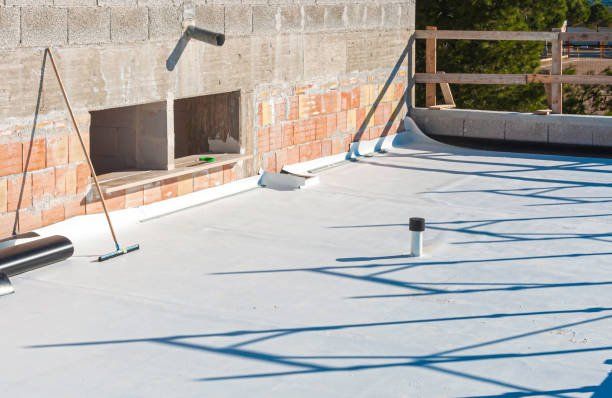Because of their inherent design, most flat roofs will eventually experience a leak. The best thing to do is address the leak when it happens to stop any further damage from taking place. Leaks can occur for several reasons, however the most common failure points are:
- Penetrations
- Holes that need to be cut in the roof for installing HVAC systems, vent pipes, drains, skylights, roof hatches, etc., are areas that are vulnerable to leaks. Attention needs to be paid in these areas to ensure proper sealing and maintenance. Accidental penetrations might also occur from people (like HVAC contractors) walking on the roof or even dropping tools.
- Seams
- Where the sheets of roofing material come together, the seam, is another vulnerable place on a roof. Because of normal wear and tear or harsh weather, the seams themselves can separate over time allowing moisture to penetrate.
- Ponding water- When water collects on a roof and fails to drain within 48 hours, ponding exists. This could indicate an issue with the roof’s drainage system.
- Membrane failure
- There are several issues that may lead to membrane failure, including environmental factors such as changes in temperature, ultraviolet rays, excessive water, and wind. These elements may lead to cracks, splits and tears in the membrane itself.
Identifying the Source of the Leak
When a leak is discovered, the first thing to do is find where the leak is coming from. However, it can sometimes be difficult to discover the real source of the leak. It’s possible that the source of water damage on your ceiling may NOT be directly above it on the roof membrane. Water that seeps in through the exterior membrane can travel for several feel until finding a weak spot in the sheathing and penetrating that area causing inside leaks.
Tips for Finding the Source of the Leak
1. Look for obvious points of water penetration. Examine the roof for any holes, punctures, popping screws, rips or tears, visibly worn-out areas, raised or separated seams, etc. If identified, you will know that is where you will need to patch the membrane.
2. If no obvious damage is identified on the membrane itself, look at flashings and caulking around your vents and other exterior roof structures. Often, leaks are located in these areas from inadequate caulking.
3. If you can’t locate the source of the leak on the roof itself, but have water spots on your ceiling, measure the distance from this spot to the nearest walls. Go back to the roof and use those measurements to narrow your search area.
4. If your roof is leaking and you can’t find the source, contact a roofer to do an inspection and repair the roof.
Repairing the Roof
Once the area where the leak is occurring has been identified, it’s time to patch it. Small holes are the easiest and fastest to fix up. A rubber sealing is directly applied to the puncture. Another option is to use a peel and stick flashing patch to the area. Blisters are more challenging to repair. A utility knife is used to cut through the blister. Next, towels (or a propane torch) are used to dry the wet area under it. Once completely dry, a peel and stick patch is applied.
If your roofing membrane has big rips or tears, these can be repaired using a peel and stick patch. However, this will require a lot more experience and skill, so it's best to contact a professional. Some types of flat roofs, such as modified bitumen, tar and gravel, PVC and TPO are challenging to repair, and require special tools and expert knowledge.
Repair Versus Replacement
Because flat roof replacement is costly and time consuming, it should really be your last resort. As we have seen, flat roofs can be repaired. However, there are some warning signs to look out for that may warrant a roof replacement. If, during a visual inspection of the roof, you see any irreparable damage of the roof, or too many cracks, bubbles, or blisters on the roof membrane, you may need a new roof. If ponding water does not effectively drain, that may be another indication. A replacement may be the only way to go when a roof is extremely damaged.
While roof replacement is a expensive option, there are several benefits. A new roof can give a new appearance for your clients and tenants, add more years to the lifespan of the building, can improve building strength and resilience, and can increase the safety of the building.








